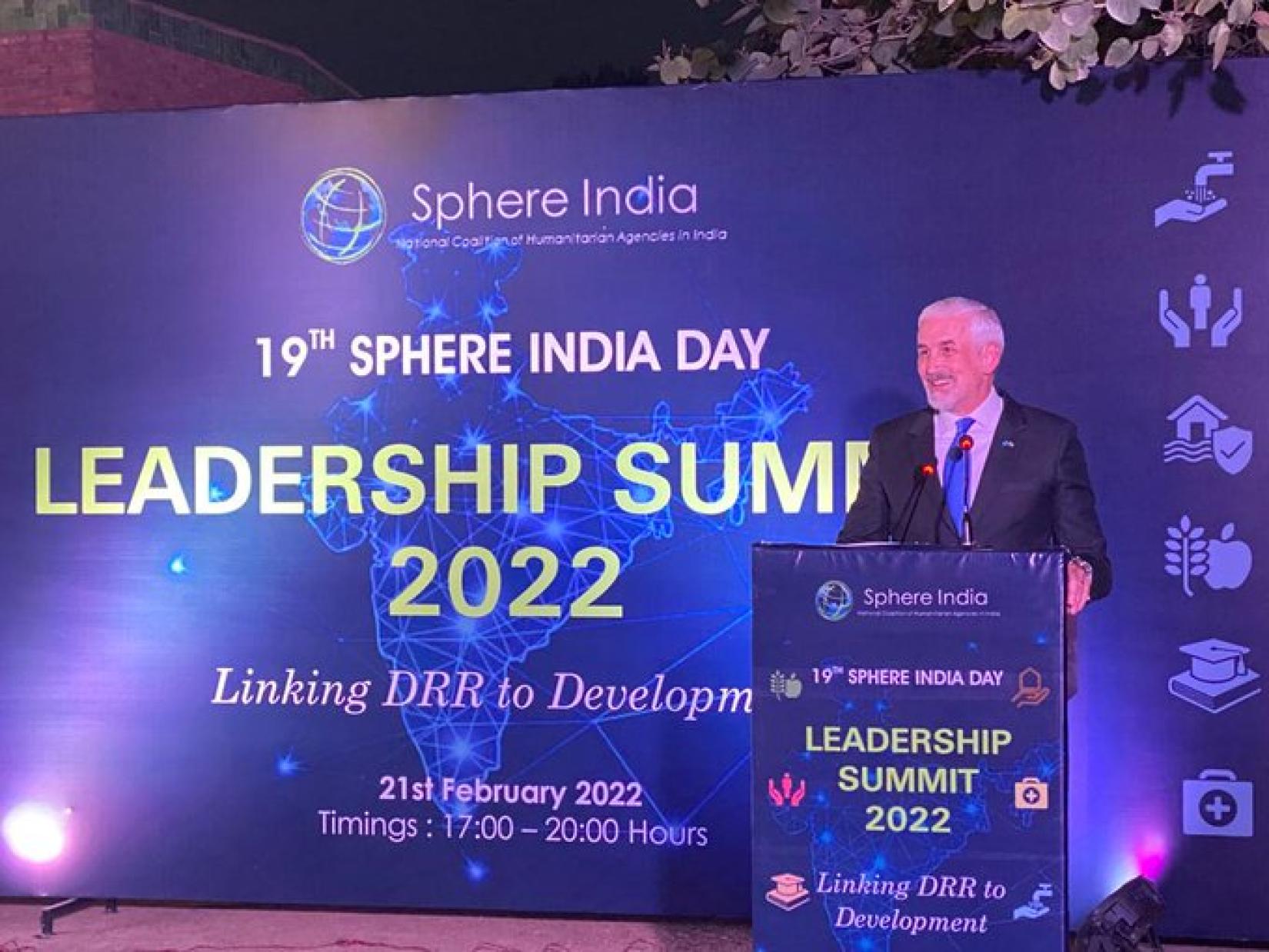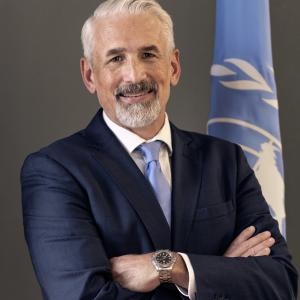Sphere India Leadership Meet
As climate-related shocks are more intense & frequent, humanitarian relief & preparedness, are complementary, needed to build resilient societies

Mr. Asif, Mr. Mahajan, distinguished colleagues from NDMA, NIDM, Ministry of Corporate Affairs, the civil society, NGO and UN partners, Namaskar and Good Evening! I am delighted to join you all today at Sphere India Leadership Meet. My heartfelt congratulations to Sphere India for 19 years helping save lives & build resilience.
· UN in India has a longstanding partnership with Sphere India. Several UN agencies, some here today, are active members of Sphere India network working together to achieve the vision of a disaster resilient India.
· And of course we work closely with the lead government institutions of the NDMAuthority, National Inst. Of Dis Man, and state & local gov’s
· And as a recent arrival, impressive to learn about Sphere’s extensive experience and capacities, across 155 Members, 805 Associate Members and some 1.8 Lakh community volunteers nationally.
· It goes without saying that 2030 Agenda for SD & 17 SDGs reaffirm the increasingly urgent need to reduce risk of disasters & build in resilience
· As climate-related shocks are more intense & frequent, as growing populations & urbanization increase people’s exposure to potential risk, as world faces challenges of increased inter-connectedness, brought into close focus by ongoing COVID pandemic, SD, humanitarian relief and preparedness, are not sequential processes: they are complementary, needed at the same time to build resilient societies.
· To reflect this understanding, the concept of a ‘humanitarian-development nexus’, emerged, focusing on coherently addressing people’s vulnerability before, during and after crises.
· The idea is not new. The nexus is a continuation of long-running efforts in the humanitarian and development fields, such as ‘disaster risk reduction’ (DRR); ‘linking relief rehabilitation and development’ (LRRD); and the ‘resilience agenda’ which now underpins the SDGs.
· Unlike previous efforts, however, the nexus dialogue goes beyond a programmatic or conceptual approach. It relates to ongoing structural shifts across systems – at the global level how aid is planned, financed & delivered, including the Grand Bargain and UN Reform – and at country level how public finance is planned and whole of government and society actors come together around resilience.
· India as in many spheres, is making important contributions globally, including through the Coalition for Disaster Resilient Infrastructure (CDRI) the partnership of governments, the UN, IFIs, the private sector, and knowledge institutions that aims to promote the resilience of new and existing infrastructure systems to climate and disaster risks in support of SD, launched by PM Modi at the 2019 UN Climate Action Summit.
· The emphasis on a more coherent approach offers many opportunities. Meeting immediate needs at the same time as ensuring longer-term investment addressing the systemic causes of vulnerability – such as poverty, inequality and accountability systems – has a better chance of reducing the impact of cyclical or recurrent shocks and stresses.
· Further, the Agenda 2030’s commitment to LNOB & reaching furthest behind 1st, and its specific references to people affected by humanitarian emergencies, creates a common framework under which both humanitarian and development actors can work together to ensure the safety, dignity and livelihood of the most vulnerable.
· The nexus approach also provides an opportunity to enhance GE, ensuring that women’s rights are integral to both immediate responses and longer-term outcomes and women are at the decision making table.
· Similarly, the potential emphasis on local leadership and the development of national and local systems to accountably provide essential social services offers the opportunity for more sustainable, appropriate and transformative responses. The current dialogue includes a welcome emphasis on early warning, early action and prevention – harnessing increasing power of technology & innovation.
· However, to further link DRR and development, it is imperative for us to understand the concept of risks in much greater depth. The COVID-19 has clearly shown us that we are living in an era of uncertainty and that risk is
systemic, and crises are cascading. One disaster may lead to another with complex and deadly consequences affecting large number of people in a disproportionate manner. Apart from COVID-19, we also face similar threats posed by CC, extreme poverty and food insecurity.
· For this reason, so pleased that capacities and partnerships here in India, represented here today, are so robust.
· In the past 4 years, our UN team in India had worked closely on two very illustrative cases of the human impact of extreme weather – the 2019 Cyclone Fani on the Eastern Coast, in Odisha, and the 2018 floods in Kerala. Both events affected millions of people and induced great losses of livelihoods. India was faced with the highest number of newly displaced people due to disasters during the second quarter of 2019.
· When we were undertaking and supporting the PDNA for both states, one thing became starkly and sharply clear to us:
· It is not enough to talk about temperature rises and get lost in aggregated numbers on CC and the triple Planetary Crisis. This crisis(es) has a human face: communities that have lost livelihoods, loved ones, homes, who face food insecurity, vector borne diseases, often forcing, widespread displacement and migration. It is estimated that CC could push 120 mln more people globally into poverty by 2030 & most severely impacting the poorest regions and people.
· And more recently, we have witnessed the heroic coming together of civil society, working in concert with government, to respond to the pandemic and save lives and livelihoods. This is the essence of SPHERE
· These catastrophic trends demand that humanitarian and development efforts to be more effectively connected, working towards achieving collective outcomes that reduce risk & vulnerability years ahead.
· In the words of the UNSG, noting the “deeply alarming” nature of each successive Intergovernmental Panel on Climate Change Report, “Good disaster risk governance means acting on science and evidence. And that requires political commitment at the highest level to deliver on the SDGs and the Sendai Framework for Disaster Risk Reduction.
· I am therefore so pleased and encouraged to see exactly that political will and commitment here in India, strengthening the collaborative disaster risk governance framework which promises better collaboration & engagements between gov’s at all levels, the private sector, civil society, academia, and communities at risks.
· And in closing I again extend my sincere gratitude and appreciation to all Sphere India member organisations for their excellent work towards building resilience, and making this collective partnership an example for the world to learn from.
· On behalf of UN System in India, I recommit our partnership, including through the next 5 year UNSDCF we are developing right now.
· Let us all aim at further scaling up our ambitions to build a resilient India and achieve the SDGs.
· Saath hai, dho sambhav hai
Dhanyavad
Speech by





